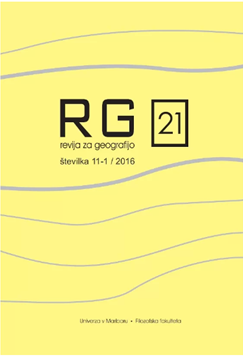Depleting State of Stratospheric Ozone: A Challenging Conservation for Global Community with special Reference to Eritrea
DOI:
https://doi.org/10.18690/rg.11.1.3949Keywords:
ozone layer, depletion, chlorofluorocarbons (CFCs), environmentAbstract
Though the basic needs of the humans are prioritized first, health and quality of environment are also equally important. Environmental issues are based on many and different things. One of these is the depleting state of Stratospheric Ozone in the atmosphere. The ozone layer is vital to life on earth because it acts as a filter for UV radiation, which can have severe impacts on human health and the earth’s environment. As estimated, every one per cent decrease in the ozone layer results in the increase of ultraviolet light intensity at the earth's surface by two per cent. Known effects of ultraviolet exposure include greater incidence of skin cancer and eye cataracts among humans and diminished crop yields for foods such as peas, beans, and squash and soya beans. Phytoplankton, the tiny one celled Ocean plants that are staple food for squid, fish, seals, and whales also are vulnerable to Ultra violet radiations. Depletion of ozone layer is one of the main issues of the world today. Concerning to these issue two important meetings had been hold i.e. known by the Montreal Protocol and Vienna Convention. Most of the world countries are part of this Montreal Protocol and Vienna Convention. Eritrea is also part of Montreal Protocol and Vienna Convention. In the present paper basically an attempt has been made to show the world’s concern in general and the Eritrea’s in particular about the conservation measures taken on mitigation of Ozone layer. This research paper also emphasizes on the global problem of Ozone Depleting Substances (ODSs) releasing from different industries and specific sources. Besides, the study further includes the existence of naturally created Ozone hole on the Polar Regions.
Downloads
References
Albritton, D. 1998: What Should Be Done in a Science Assessment In Protecting the Ozone Layer: Lessons, Models, and Prospects.
Allied Signal Corporation. “Remarks,” International CFC and Halon Alternatives Conference. Washington, DC. 1989.
Alternative Fluorocarbons Environmental Acceptability Study (AFEAS), Washington, DC, 1995.
Andelin, D., John, V. 1988: Analysis of the Montreal Protocol, Staff report, U.S. Congress, Office of Technology Assessment, Jan. 13, 1988.
Angell, J. K., Korshover, J. 2005: Quasi-biennial and Long-term Fluctuations in Total Ozone, Monthly Weather Review vol. 101, pp.426–43.
Anderson, J. G. 2008: The Measurement of Trace Reactive Species in the Stratosphere: An Overview. In Causes and Effects of Stratospheric Ozone Depletion: An Update, Washington, DC: National Academy Press.
Stedman, D. H. 1981: Atomic Chlorine : Three in Situ Observations. Science, vol.198. 10.1126/science.198.4316.50
Interviews with refrigeration technicians: Tesfalem, Hagos, Kahesai, Mogos and Halisslassie, April 2015.
Open interviews with Mr. Kebrom Asmelash (head officer of ozone unit), 2nd May, 2016.
Stephen, O., Morehouse, E. T. Jr., Miller, A. 1994: The Military’s Role in Protection of the Ozone Layer. Environmental Science and Technology, vol 28, no. 13. https://doi.org/10.1021/es00062a719
United Nations Environment Programme (UNEP): strategies and policies for the implementation of the Montreal protocol in Norway. In: Environmental Management in developed countries, pp. 19-22, 1997.
United Nations Environment Programme (UNEP): Protecting the Ozone layer Vol.1 refrigerants 2001.
United Nations Environment Programme (UNEP): Protecting the Ozone layer Vol.6 Methyl bromide.
Downloads
Published
Issue
Section
License
Copyright (c) 2016 Mohammad Afsar Alam

This work is licensed under a Creative Commons Attribution 4.0 International License.
